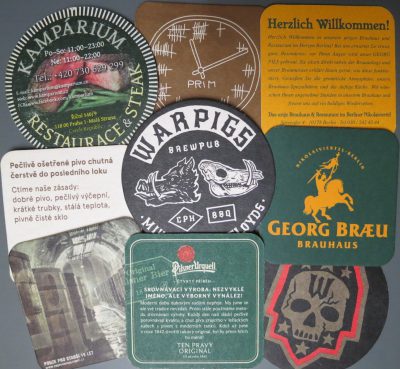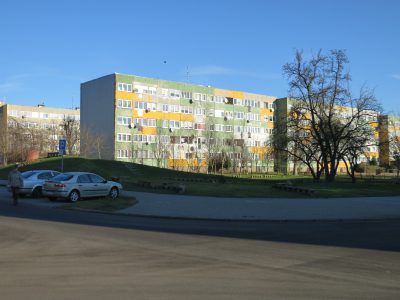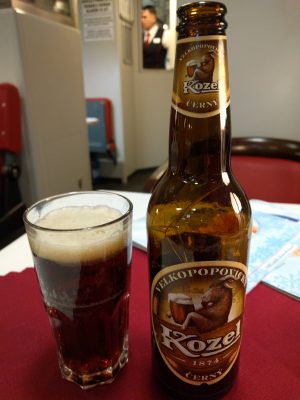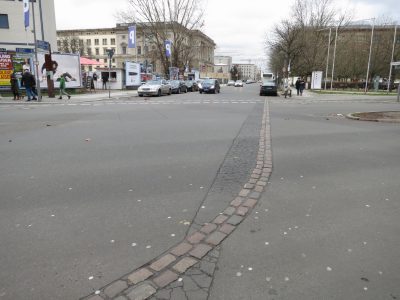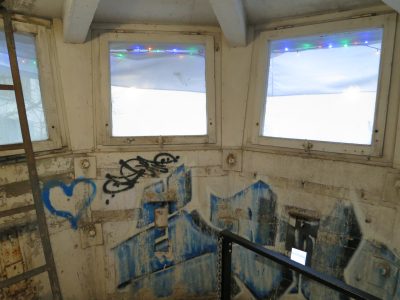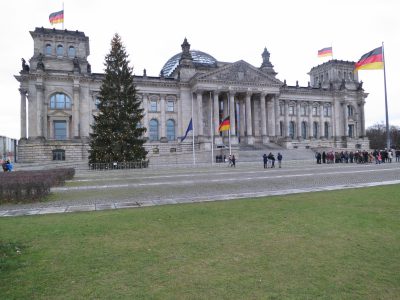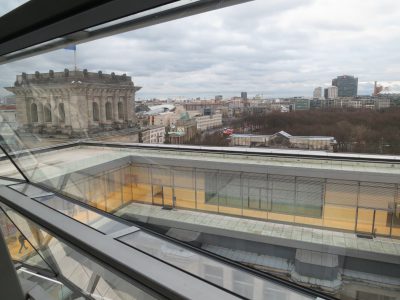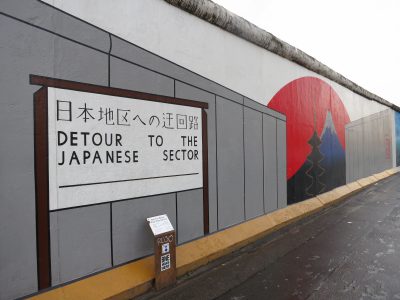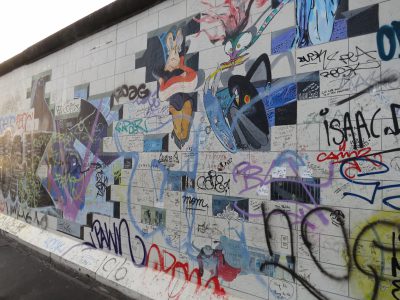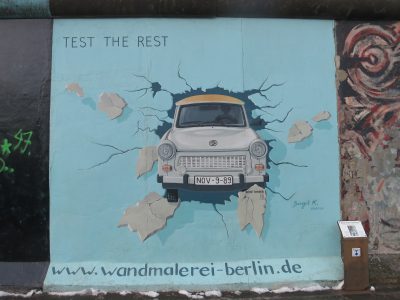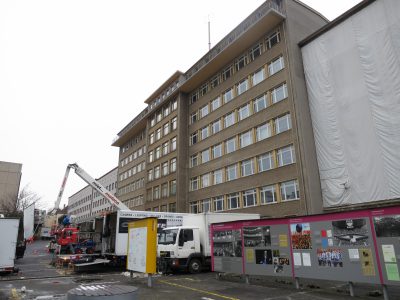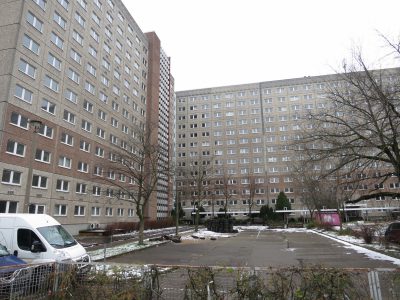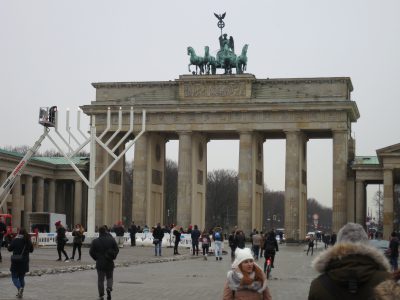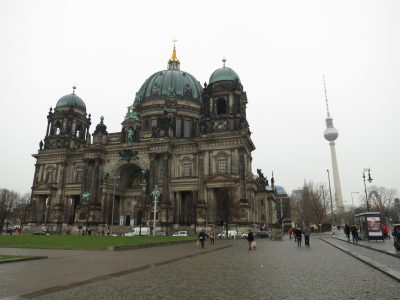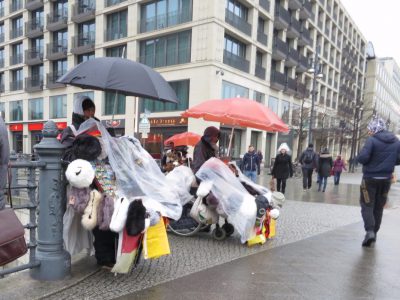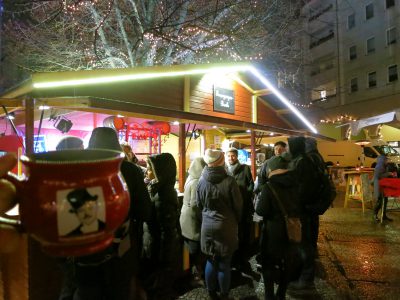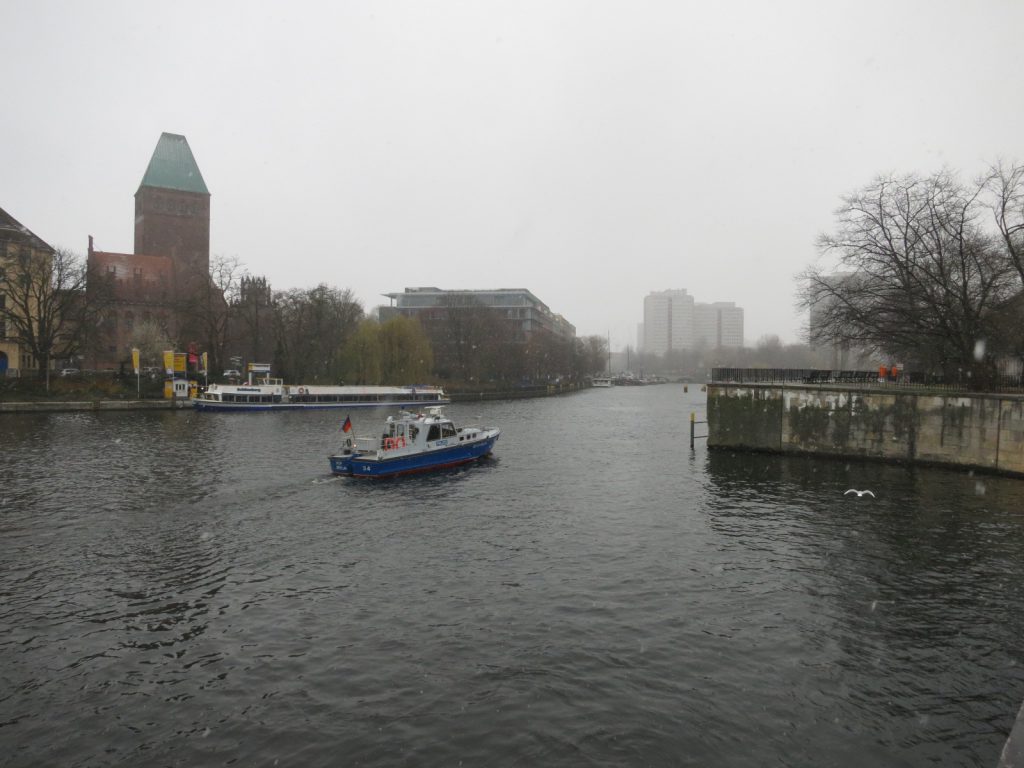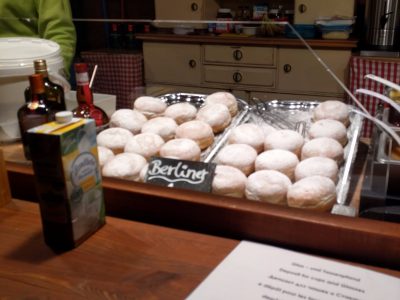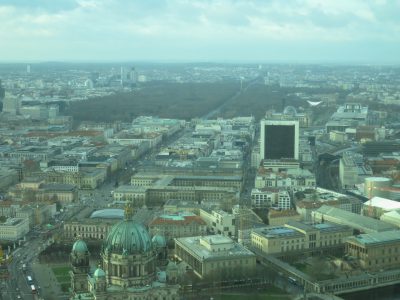Tag Archives: germany
Photos on flickr
Photos are up on flickr. There are two categories:
- Photos you’ve already seen.
- Photos that weren’t good enough for the blog.
And the final route:
Not shown: Bloody Heathrow.
Final Notes
I made it back. Walk to tram, tram to bus, bus to airport, long check-in line, walk to gate, fly to Heathrow, go through seemingly endless labyrinthine hellscape at Heathrow, fly to Seattle, go through Customs, walk to shuttle, shuttle to car, drive home. Roughly 21 hours. I think 19 of that was in Heathrow, although BA upgraded me and let me pre-board for no apparent reason. Maybe they liked the cut of my jib, although honestly my jib was looking pretty rumpled at that point.
Some final notes:
- I learned to say seven things in Czech: Dobrý den (good day), prosím (please), pivo (beer), káva (coffee), pokladna (cash register), papriková klobása (paprika kielbasa), and trdelník (trdelník).
- Danish trucks don’t make a beeping noise when they back up.
- On all the local transportation I rode (trams, subways, buses, etc.) in Copenhagen, Berlin, and Prague, I don’t think anyone ever checked my ticket. I’ve read that Prague spot-checks riders and will fine you 700 Kč if you don’t have a valid ticket. But a three-day ticket is 310 Kč, so if they check less than once per week, you’d come out ahead by paying the fine.
- Thai massage seems to be a thing in Prague. They’re all over the place. One aspect of Thai massage involves putting your feet in a fish tank so that fish can nibble them. This takes place in the front window so that you, the idiot tourist, are on display to passersby while fish nibble your toes. I did not do this.
- I now understand the line from the 2013 David Bowie song “Where Are We Now”.
Had to get the train
From Potsdamer Platz
You never knew that
That I could do that
Meistersaal studio, near Potsdamer Platz, was where Bowie and Iggy Pop recorded in 1977. Potsdamer Platz was one of the ghost stations of the U-Bahn. It was in the east, but the stations on either side were in the west. Trains were not allowed to stop there and guards were posted in the station to make sure they didn’t. West Berlin had to pay the DDR for the privilege of passing through. - I walked a total of 118.44 miles over 18 days, for an average of 6.58 miles per day.
- I really need to bring less luggage.
Görlitz & Zgorzelec
These are two towns on opposite sides of the Neisse river. Before the river was set as the border in 1945, they were the same town, and they’re now effectively twin cities. You can walk across a foot bridge between them.
I remembered all of this from an earlier version of the Rick Steves guidebook on Germany, but it isn’t in the current edition. Still, I remembered that it was supposed to be a picturesque little town.
Parts of the German side are, but not any more than you would see elsewhere in Germany. The Polish side probably has a center of town somewhere, but I certainly wasn’t able to find it. The tourist map they give out in Görlitz cuts off most of Zgorzelec.
To make matters worse, I was on my way from Berlin to Prague, so I had all my luggage with me, and there’s a steep hill down to the river, and a steep hill up the other side. Google Maps drained my battery again, so I couldn’t use that, which left me just picking a likely-looking direction.
All I found was a residential area with Soviet architecture. I made a big loop and walked back to the bridge.
Back on the German side of the bridge, I stopped to look at the map and collect my thoughts before trudging back up the hill with my luggage. As I started to cross the street, I was approached (in fact, surrounded) by three polizei who wanted to see my passport. As I started to hand it over, I remembered that I had tucked some Swiss and Danish currency in it, so I quickly pulled that out, lest he think I was trying to bribe him with roughly $15 worth of foreign currency.
Poland and Germany are both in the Schengen area, so crossing that border shouldn’t require a passport, but I guess someone crossing on foot with a lot of luggage might look a little suspicious. Fortunately, he saw my entry stamp from Copenhagen and concluded that I was legal.
Having thus made it past the polizei, I trudged up the hill to the center of town.
My phone battery was dead, but I knew I would need it to contact the Airbnb people once I got to Prague, so I found a place with a plug and bought pastries and cappuccinos until my phone was about 2/3 charged. I would have stayed longer, but the plug was right by the door, so I was partially blocking the entrance by standing there.
The train trip from Görlitz to Prague was uneventful. For the final leg from Dresden, I had a first-class ticket and had a nice dinner in the dining car shortly before arriving. This included a Czech beer that is seemingly popular with goats.
When I arrived in Prague, in a freakish twist of fate, everything went smoothly. I found an ATM and withdrew 3000 koruna, bought a three-day tram ticket from a machine, figured out the location of the tram stop right away, and got to the stop just as my tram was arriving. I got to the Airbnb apartment in about 15 minutes, and the owner showed up a few minutes later to let me in.
Not wanting to press my luck further, I think I’ll turn in for the night.
Potsdamer Platz
After the Reichstag, I came back to the hotel and lounged around for a while. I didn’t really plan to go anywhere except KaDeWe in the late afternoon, but I got tired of lounging, so I went to Potsdamer Platz, which is on the way to KaDeWe.
Potsdamer Platz was right on the junction of the American, British, and Russian sectors, so the Wall ran right through it. There were some apartments and businesses overlooking the Wall (such as the studio where David Bowie and Iggy Pop recorded), but much of the area had been destroyed in the war and not rebuilt, or cleared away to form the no-man’s land between east and west. Most of what’s there now is less than 20 years old.
The location of the Wall is marked by a double row of bricks in the pavement.
I didn’t realize this until I got there, but down a side street is the last remaining BT 6 Watchtower of the DDR, just standing there on the sidewalk.
And this being December, it has a Santa hat.
The tower is a city monument, but it doesn’t receive any money. It’s run entirely by volunteers. Today it was staffed by a friendly woman named Susi who had worked in the Potsdamer Platz area in the mid-’80s and could see this tower from where she worked.
I climbed up in and looked around. Visibility is good, but there’s not a lot of space up there.
After the tower, I took the train to Wittenbergplatz and walked down Tauentzienstraße until I got too cold. By then it was time for an early dinner at the Wintergarten buffet on the top floor of KaDeWe. This is the most spectacular buffet I’ve ever seen. I recommend the Apfelstrudel.
Now I need to pack. My train leaves Berlin tomorrow at 0630.
Der Reichstag
This morning I visited the Reichstag building at 8:00 AM. It’s free, but you have to make an appointment, and the only remaining choices while I was here were early morning and late night.
The appointment was just for the dome, which was added in 1999. You get a recorded audio guide in your preferred language and wind your way slowly to the top, then back down again. It’s open at the top and bottom for air circulation, and the mirrors adjust to provide natural light to the parliamentary chambers below.
I had forgotten that Christo wrapped the building in 1995.
Fun fact: The original building was ruined in World War 2, and the inside was gutted and rebuilt in the 1960s. Then it was gutted and rebuilt again after reunification. Only the outer walls are original. The insides look like an ordinary office building.
Stasi, KaDeWe, & Feuerzangenbowle
My foot and knee are still bothering me, and probably won’t recover until I stay off them for a while. So naturally today I walked almost eleven miles.
In the morning I went across the river to the East Side Gallery, which is a mile-long section of the Wall that was given over to artwork in 1990 and restored in 2009.
A lot of it is overtly political, not surprisingly, like this famous picture of Brezhnev and Honecker kissing, which until this trip I did not realize was based on a photo and the actual practice of communist heads of state.
Hard to imagine kissing Brezhnev. That’s the stuff of nightmares, that is. Not that Honecker would be a delight, but Brezhnev is somehow worse.
Some of the pieces are more fanciful.
There are signs threatening prosecution for defacing the murals, but a lot of them have graffiti anyway, like this Pink Floyd piece.
Of course the best is this one. Somewhere there’s a companion piece showing the other side, but I don’t know where it is. There are bits of the Wall all over the place.
From there it was only a short hop on the U-Bahn to the Stasi museum, inside the old Stasi headquarters. There was a film crew there, so I wasn’t able to see Erich Mielke’s office, but I did snoop in some of the lesser offices when the film people weren’t paying attention.
At its peak, the Stasi complex covered 54 acres, with 50 office buildings.
From there I took the train to the Checkpoint Charlie area. Of course it’s not the real Checkpoint Charlie, because that’s long gone, but everyone’s heard of Checkpoint Charlie and expects to see it, so they have a fake one. There’s also a Checkpoint Charlie museum and a film experience and a whole lot of souvenir shops all selling the same souvenirs. I bought a shirt.
Then I walked over to Unter den Linden and bought another shirt. Then I walked to the Brandenburg Gate, where someone was assembling a giant menorah.
Hitler would plotz.
Then I walked up Unter den Linden. Initially I was identifying things in the guidebook as I went, but it was getting colder and I started walking faster and I left my guidebook, and my hands, in my pockets most of the time, so I don’t know what everything was along the way.
In all of the tourist areas, there are guys selling genuine East German and Soviet hats and pins and flags. Absolutely for-sure real stuff.
Some of the stores are even still selling pieces of the Wall. And in case you doubt them, they come with a certificate of authenticity. And certified authenticity is the most authentic authenticity.
After a brief stop at the hotel, I took the train to Kaufhaus des Westens, aka KaDeWe, the largest department store in continental Europe. All of it is impressive, but the food market is amazing. It’s an entire floor of cafes, delis, bakeries, candy stores, grocery stores, wine bars, and any other food-related thing you can think of. It is to an ordinary food court what West Berlin was to East Berlin. I think I spent close to an hour just wandering around on that floor.
After I left KaDeWe, I got on the train going in the wrong direction. Could happen to anyone, really.
Eventually I made it back to Alexanderplatz and stopped in the Nikolaiviertel for a Feuerzangenbowle, as one does this time of year.
“Feuerzangenbowle,” it says here in Wikipedia, “is a traditional German alcoholic drink for which a rum-soaked sugarloaf is set on fire and drips into mulled wine. It is often part of a Christmas or New Year’s Eve tradition. The name translates literally to fire-tongs punch.” It’s a close relative to glühwein and thus to gløgg, but probably a bit stronger.
The venue selling this concoction was right next to the Nikolaikirche, a (mostly reconstructed) 13th-century church that is now a museum. They seem to be connected to it in some way. They sell this drink and a few others and have the 1944 movie Die Feuerzangenbowle running on a continuous loop.
The Nikolaiviertel itself is supposedly the historical center of Berlin. The church is legitimate, even if it’s mostly a restoration, and some of the other buildings are authentic, too. They’re just not necessarily authentic from that particular location. And a lot of the others are idealized recreations.
All of this was put together by the East German government for Berlin’s 750th anniversary in 1987. It’s sort of a Germanic Main Street USA.


